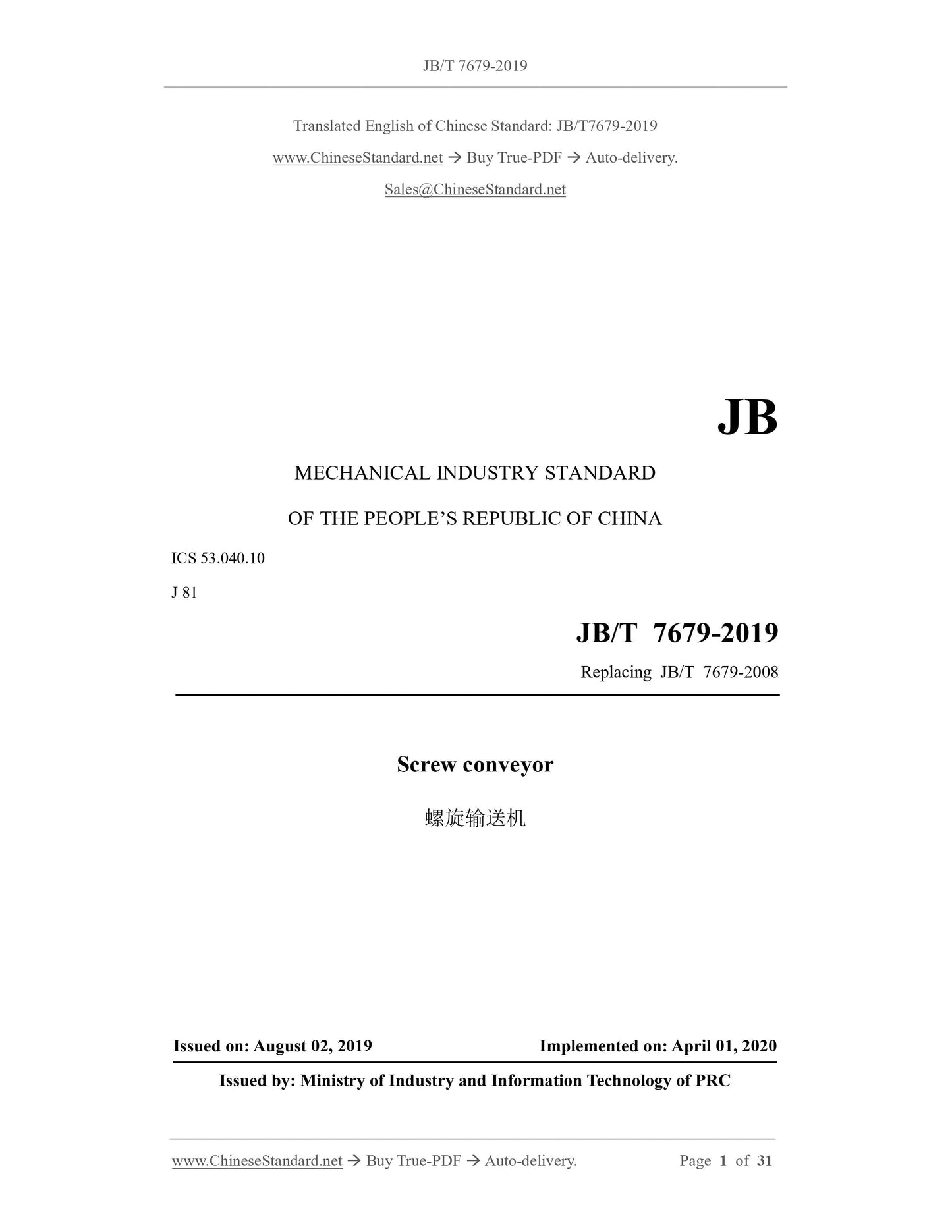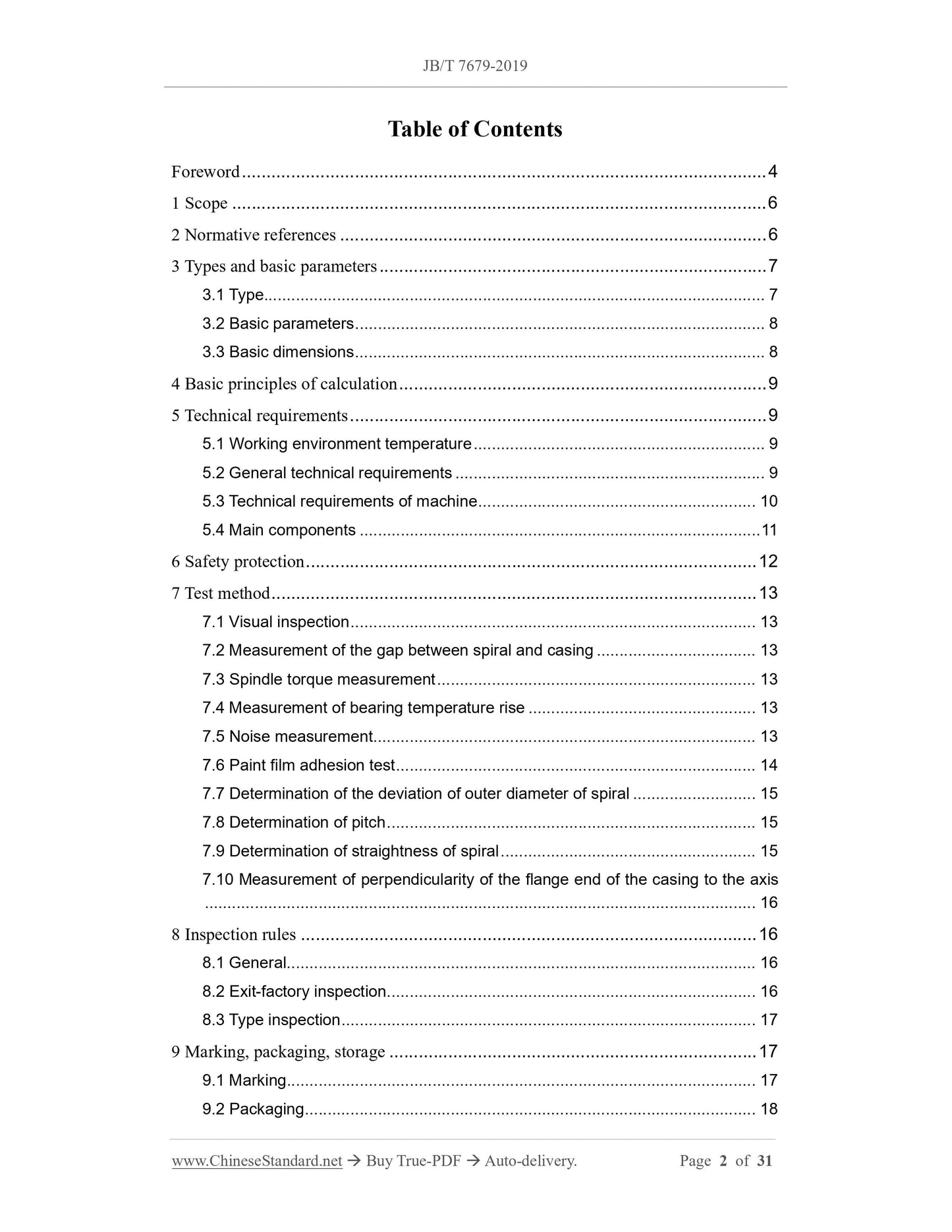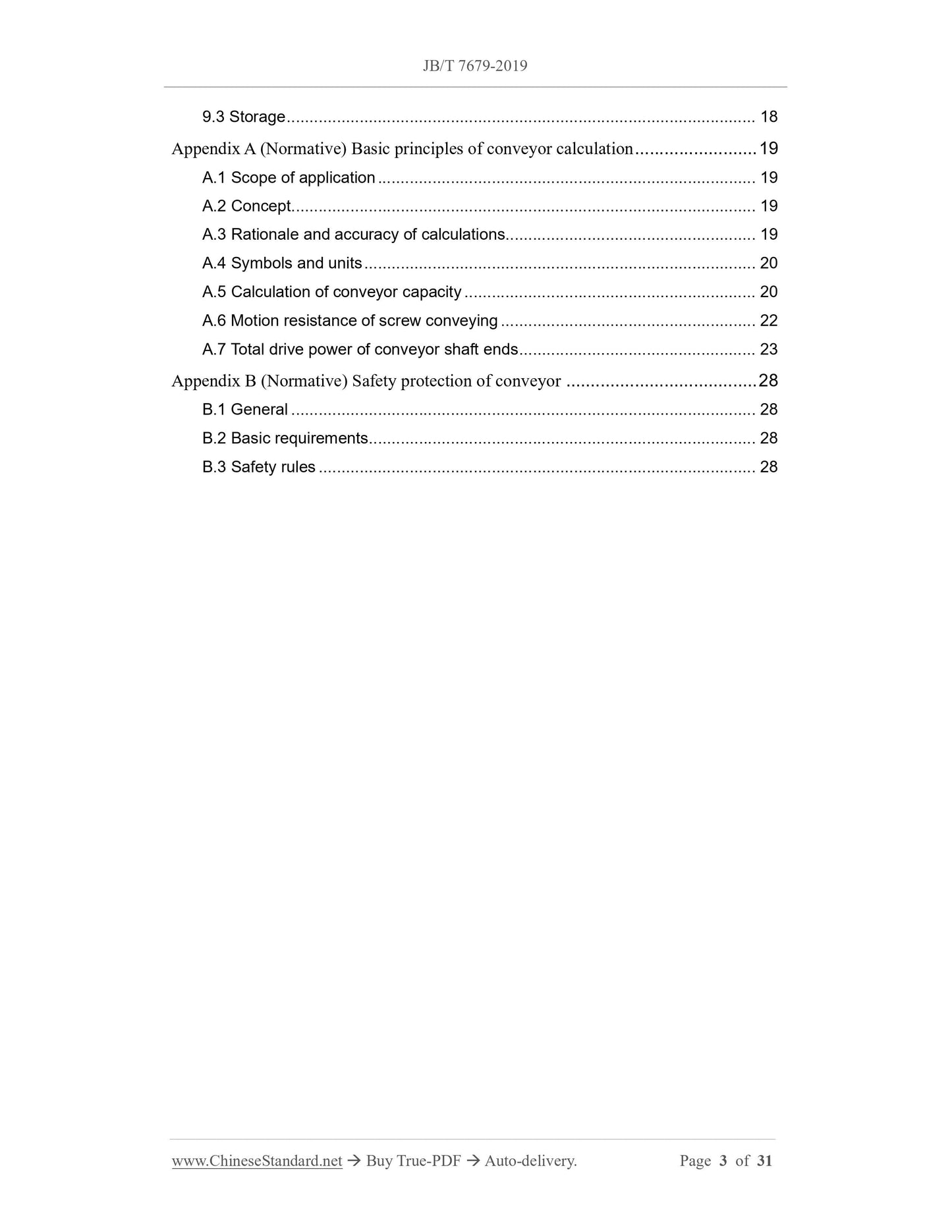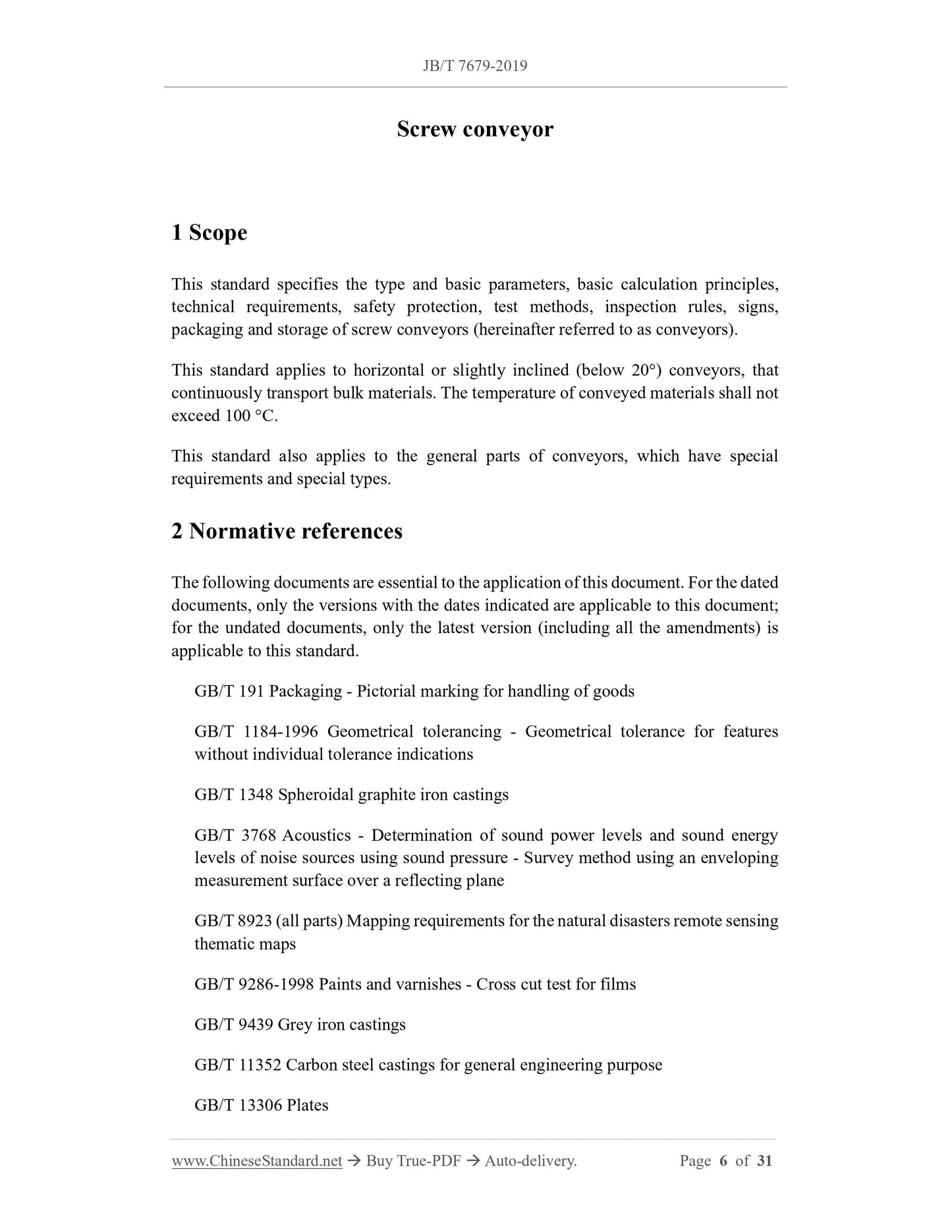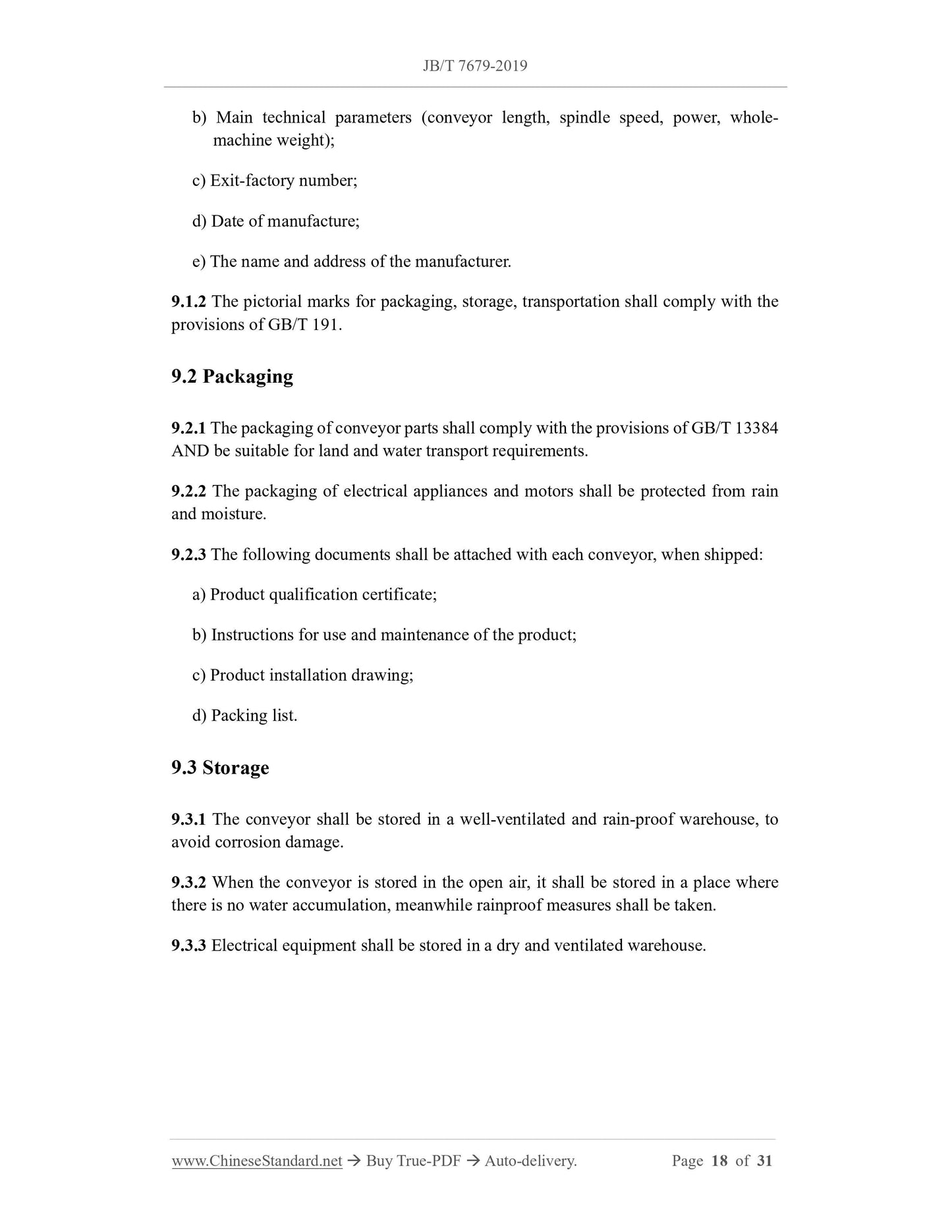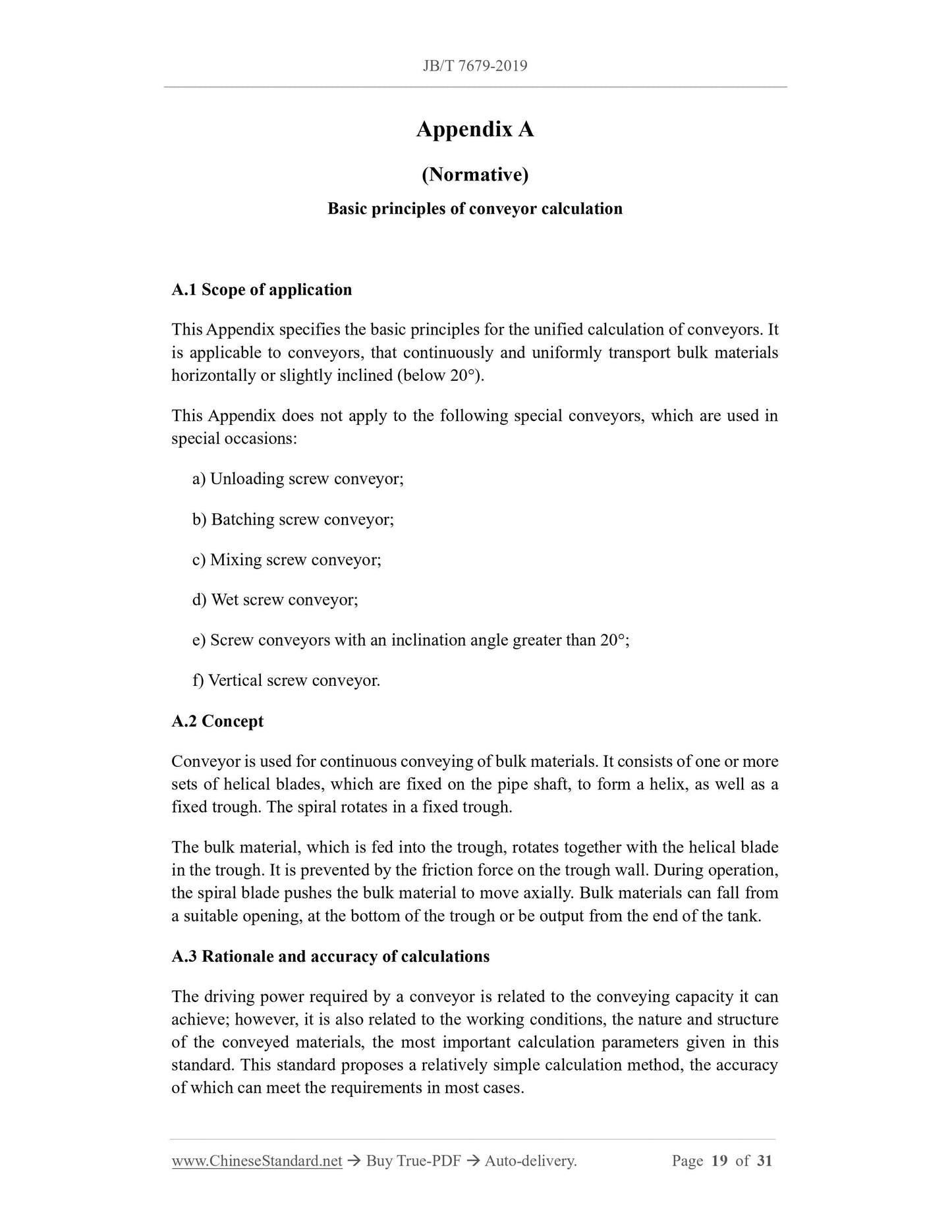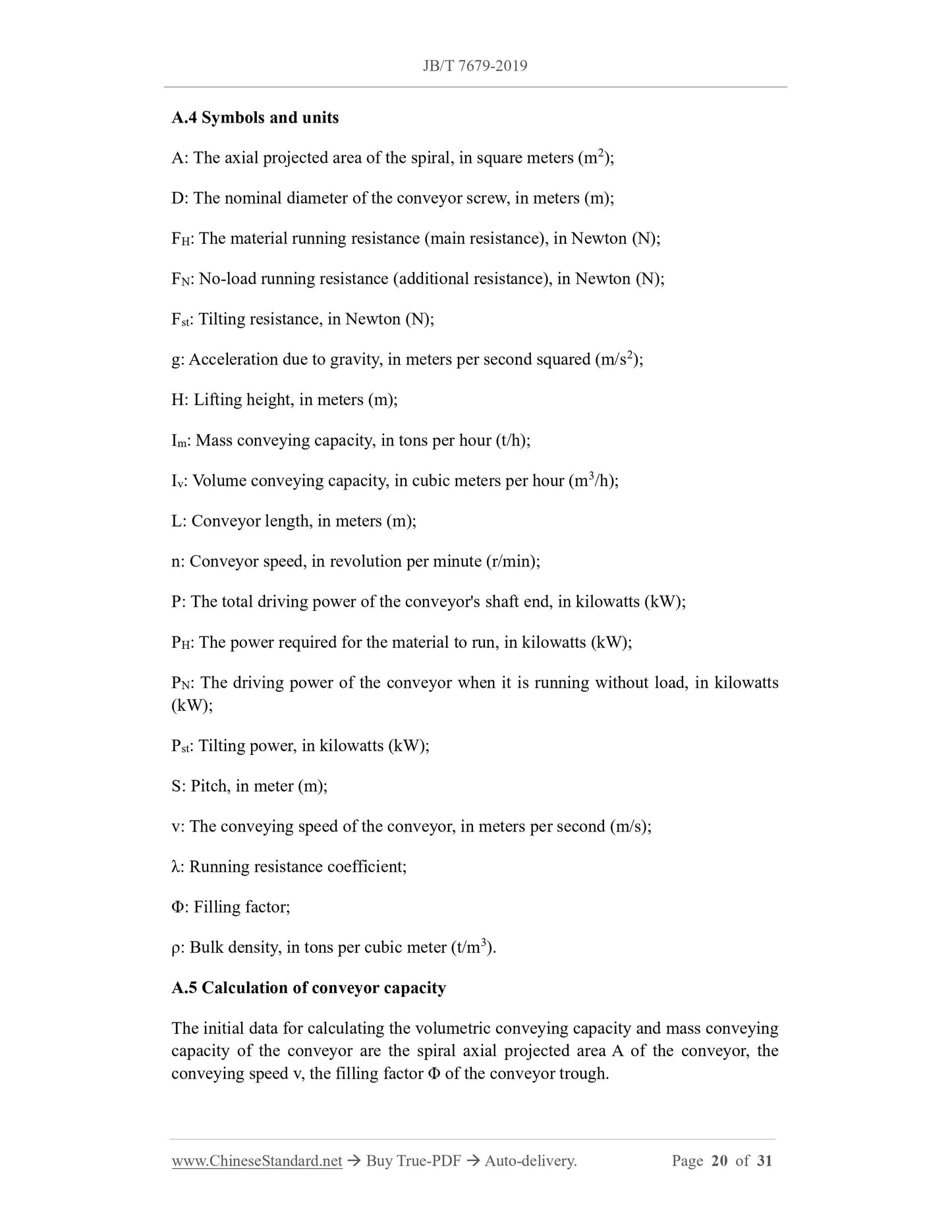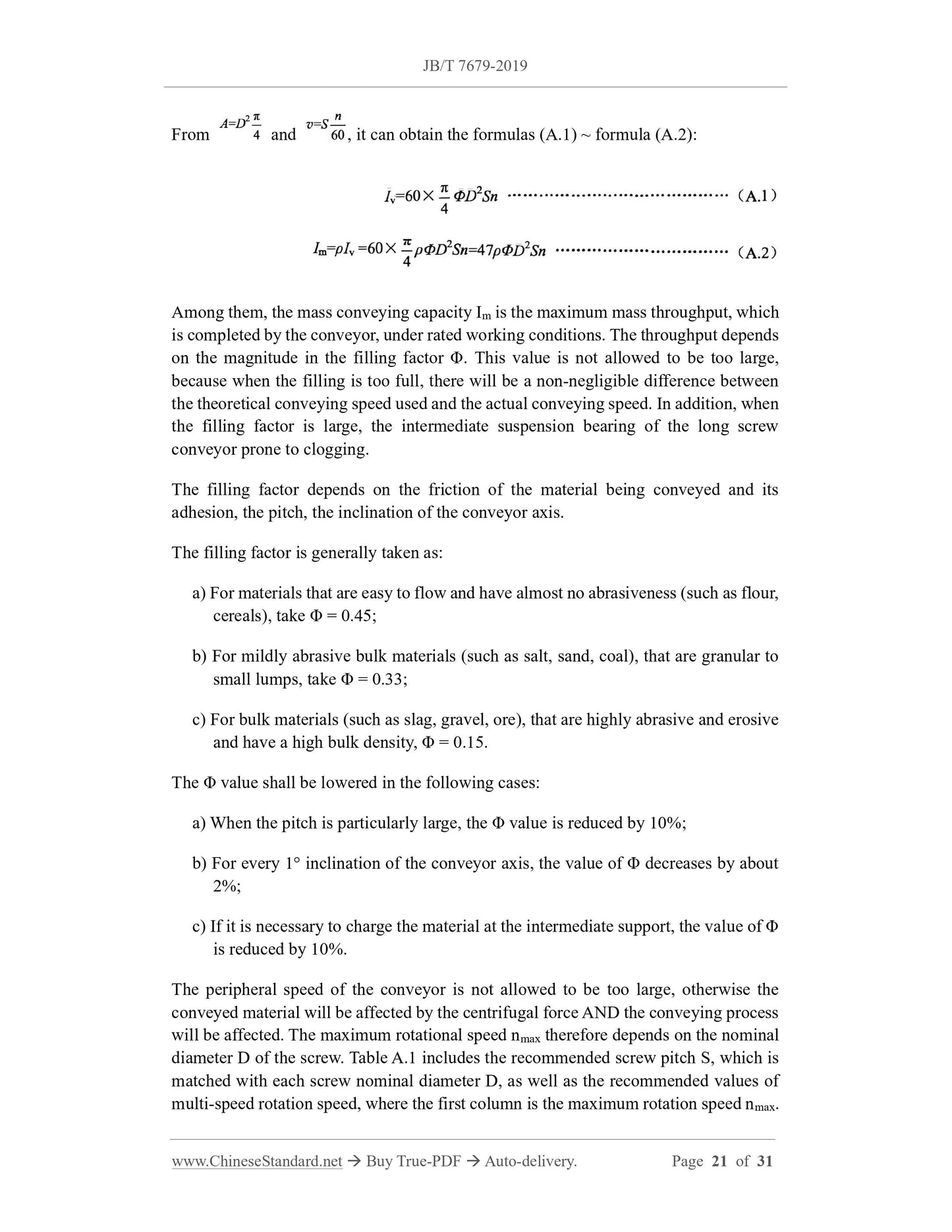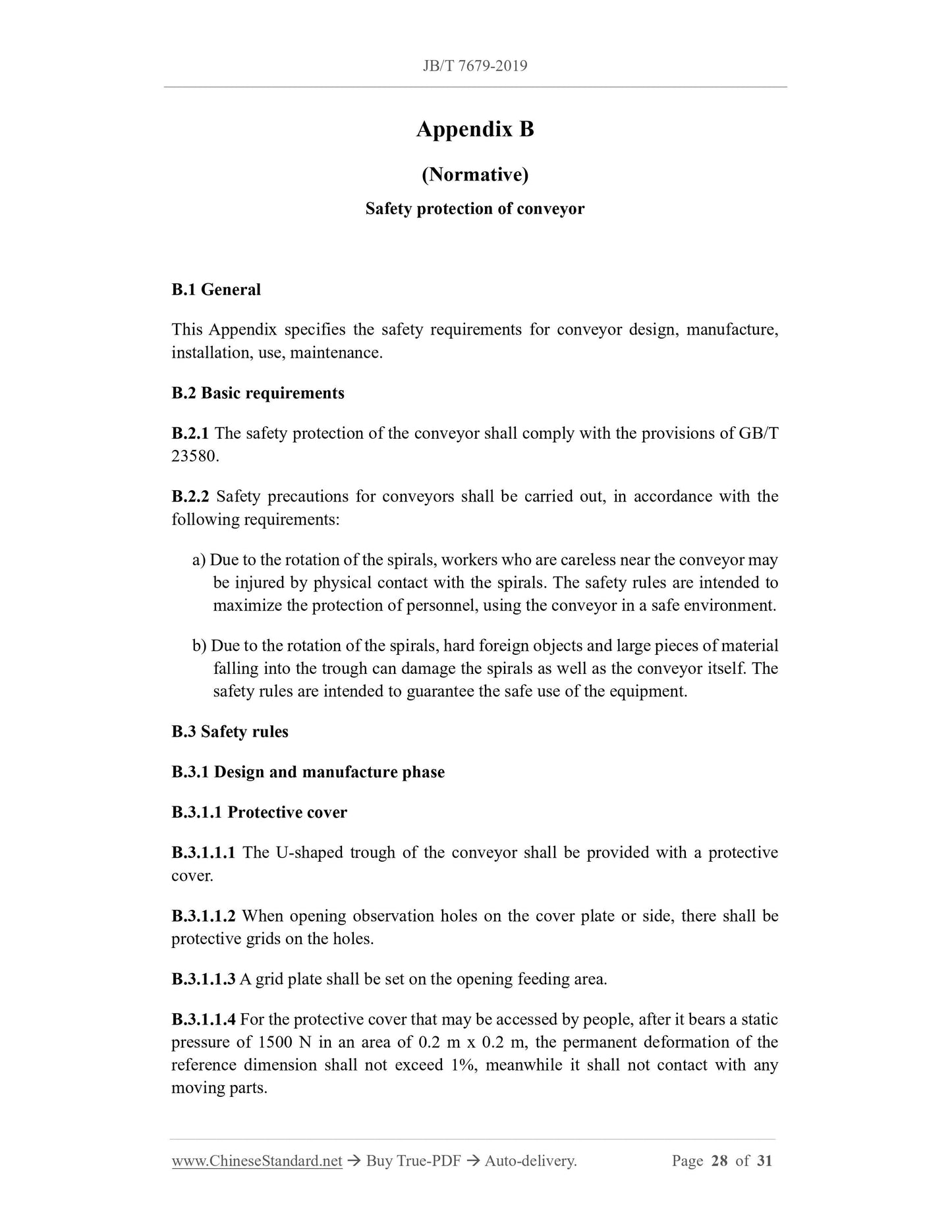1
/
of
9
www.ChineseStandard.us -- Field Test Asia Pte. Ltd.
JB/T 7679-2019 English PDF (JB/T7679-2019)
JB/T 7679-2019 English PDF (JB/T7679-2019)
Regular price
$325.00
Regular price
Sale price
$325.00
Unit price
/
per
Shipping calculated at checkout.
Couldn't load pickup availability
JB/T 7679-2019: Screw conveyor
Delivery: 9 seconds. Download (& Email) true-PDF + Invoice.
Get Quotation: Click JB/T 7679-2019 (Self-service in 1-minute)
Historical versions (Master-website): JB/T 7679-2019
Preview True-PDF (Reload/Scroll-down if blank)
JB/T 7679-2019
JB
MECHANICAL INDUSTRY STANDARD
OF THE PEOPLE’S REPUBLIC OF CHINA
ICS 53.040.10
J 81
Replacing JB/T 7679-2008
Screw conveyor
ISSUED ON: AUGUST 02, 2019
IMPLEMENTED ON: APRIL 01, 2020
Issued by: Ministry of Industry and Information Technology of PRC
Table of Contents
Foreword ... 4
1 Scope ... 6
2 Normative references ... 6
3 Types and basic parameters ... 7
3.1 Type... 7
3.2 Basic parameters ... 8
3.3 Basic dimensions ... 8
4 Basic principles of calculation ... 9
5 Technical requirements ... 9
5.1 Working environment temperature ... 9
5.2 General technical requirements ... 9
5.3 Technical requirements of machine ... 10
5.4 Main components ... 11
6 Safety protection ... 12
7 Test method ... 13
7.1 Visual inspection ... 13
7.2 Measurement of the gap between spiral and casing ... 13
7.3 Spindle torque measurement ... 13
7.4 Measurement of bearing temperature rise ... 13
7.5 Noise measurement ... 13
7.6 Paint film adhesion test ... 14
7.7 Determination of the deviation of outer diameter of spiral ... 15
7.8 Determination of pitch ... 15
7.9 Determination of straightness of spiral ... 15
7.10 Measurement of perpendicularity of the flange end of the casing to the axis
... 16
8 Inspection rules ... 16
8.1 General ... 16
8.2 Exit-factory inspection ... 16
8.3 Type inspection ... 17
9 Marking, packaging, storage ... 17
9.1 Marking ... 17
9.2 Packaging ... 18
9.3 Storage ... 18
Appendix A (Normative) Basic principles of conveyor calculation ... 19
A.1 Scope of application ... 19
A.2 Concept ... 19
A.3 Rationale and accuracy of calculations ... 19
A.4 Symbols and units ... 20
A.5 Calculation of conveyor capacity ... 20
A.6 Motion resistance of screw conveying ... 22
A.7 Total drive power of conveyor shaft ends ... 23
Appendix B (Normative) Safety protection of conveyor ... 28
B.1 General ... 28
B.2 Basic requirements... 28
B.3 Safety rules ... 28
Screw conveyor
1 Scope
This standard specifies the type and basic parameters, basic calculation principles,
technical requirements, safety protection, test methods, inspection rules, signs,
packaging and storage of screw conveyors (hereinafter referred to as conveyors).
This standard applies to horizontal or slightly inclined (below 20°) conveyors, that
continuously transport bulk materials. The temperature of conveyed materials shall not
exceed 100 °C.
This standard also applies to the general parts of conveyors, which have special
requirements and special types.
2 Normative references
The following documents are essential to the application of this document. For the dated
documents, only the versions with the dates indicated are applicable to this document;
for the undated documents, only the latest version (including all the amendments) is
applicable to this standard.
GB/T 191 Packaging - Pictorial marking for handling of goods
GB/T 1184-1996 Geometrical tolerancing - Geometrical tolerance for features
without individual tolerance indications
GB/T 1348 Spheroidal graphite iron castings
GB/T 3768 Acoustics - Determination of sound power levels and sound energy
levels of noise sources using sound pressure - Survey method using an enveloping
measurement surface over a reflecting plane
GB/T 8923 (all parts) Mapping requirements for the natural disasters remote sensing
thematic maps
GB/T 9286-1998 Paints and varnishes - Cross cut test for films
GB/T 9439 Grey iron castings
GB/T 11352 Carbon steel castings for general engineering purpose
GB/T 13306 Plates
b) Main technical parameters (conveyor length, spindle speed, power, whole-
machine weight);
c) Exit-factory number;
d) Date of manufacture;
e) The name and address of the manufacturer.
9.1.2 The pictorial marks for packaging, storage, transportation shall comply with the
provisions of GB/T 191.
9.2 Packaging
9.2.1 The packaging of conveyor parts shall comply with the provisions of GB/T 13384
AND be suitable for land and water transport requirements.
9.2.2 The packaging of electrical appliances and motors shall be protected from rain
and moisture.
9.2.3 The following documents shall be attached with each conveyor, when shipped:
a) Product qualification certificate;
b) Instructions for use and maintenance of the product;
c) Product installation drawing;
d) Packing list.
9.3 Storage
9.3.1 The conveyor shall be stored in a well-ventilated and rain-proof warehouse, to
avoid corrosion damage.
9.3.2 When the conveyor is stored in the open air, it shall be stored in a place where
there is no water accumulation, meanwhile rainproof measures shall be taken.
9.3.3 Electrical equipment shall be stored in a dry and ventilated warehouse.
Appendix A
(Normative)
Basic principles of conveyor calculation
A.1 Scope of application
This Appendix specifies the basic principles for the unified calculation of conveyors. It
is applicable to conveyors, that continuously and uniformly transport bulk materials
horizontally or slightly inclined (below 20°).
This Appendix does not apply to the following special conveyors, which are used in
special occasions:
a) Unloading screw conveyor;
b) Batching screw conveyor;
c) Mixing screw conveyor;
d) Wet screw conveyor;
e) Screw conveyors with an inclination angle greater than 20°;
f) Vertical screw conveyor.
A.2 Concept
Conveyor is used for continuous conveying of bulk materials. It consists of one or more
sets of helical blades, which are fixed on the pipe shaft, to form a helix, as well as a
fixed trough. The spiral rotates in a fixed trough.
The bulk material, which is fed into the trough, rotates together with the helical blade
in the trough. It is prevented by the friction force on the trough wall. During operation,
the spiral blade pushes the bulk material to move axially. Bulk materials can fall from
a suitable opening, at the bottom of the trough or be output from the end of the tank.
A.3 Rationale and accuracy of calculations
The driving power required by a conveyor is related to the conveying capacity it can
achieve; however, it is also related to the working conditions, the nature and structure
of the conveyed materials, the most important calculation parameters given in this
standard. This standard proposes a relatively simple calculation method, the accuracy
of which can meet the requirements in most cases.
A.4 Symbols and units
A: The axial projected area of the spiral, in square meters (m2);
D: The nominal diameter of the conveyor screw, in meters (m);
FH: The material running resistance (main resistance), in Newton (N);
FN: No-load running resistance (additional resistance), in Newton (N);
Fst: Tilting resistance, in Newton (N);
g: Acceleration due to gravity, in meters per second squared (m/s2);
H: Lifting height, in meters (m);
Im: Mass conveying capacity, in tons per hour (t/h);
Iv: Volume conveying capacity, in cubic meters per hour (m3/h);
L: Conveyor length, in meters (m);
n: Conveyor speed, in revolution per minute (r/min);
P: The total driving power of the conveyor's shaft end, in kilowatts (kW);
PH: The power required for the material to run, in kilowatts (kW);
PN: The driving power of the conveyor when it is running without load, in kilowatts
(kW);
Pst: Tilting power, in kilowatts (kW);
S: Pitch, in meter (m);
v: The conveying speed of the conveyor, in meters per second (m/s);
λ: Running resistance coefficient;
Φ: Filling factor;
ρ: Bulk density, in tons per cubic meter (t/m3).
A.5 Calculation of conveyor capacity
The initial data for calculating the volumetric conveying capacity and mass conveying
capacity of the conveyor are the spiral axial projected area A of the conveyor, the
conveying speed v, the filling factor Φ of the conveyor trough.
From and , it can obtain the formulas (A.1) ~ formula (A.2):
Among them, the mass conveying capacity Im is the maximum mass throughput, which
is completed by the conveyor, under rated working conditions. The throughput depends
on the magnitude in the filling factor Φ. This value is not allowed to be too large,
because when the filling is too full, there will be a non-negligible difference between
the theoretical conveying speed used and the actual conveying speed. In addition, when
the filling factor is large, the intermediate suspension bearing of the long screw
conveyor prone to clogging.
The filling factor depends on the friction of the material being conveyed and its
adhesion, the pitch, the inclination of the conveyor axis.
The filling factor is generally taken as:
a) For materials that are easy to flow and have almost no abrasiveness (such as flour,
cereals), take Φ = 0.45;
b) For mildly abrasive bulk materials (such as salt, sand, coal), that are granular to
small lumps, take Φ = 0.33;
c) For bulk materials (such as slag, gravel, ore), that are highly abrasive and erosive
and have a high bulk density, Φ = 0.15.
The Φ value shall be lowered in the following cases:
a) When the pitch is particularly large, the Φ value is reduced by 10%;
b) For every 1° inclination of the conveyor axis, the value of Φ decreases by about
2%;
c) If it is necessary to charge the material at the intermediate support, the value of Φ
is reduced by 10%.
The peripheral speed of the conveyor is not allowed to be too large, otherwise the
conveyed material will be affected by the centrifugal force AND the conveying process
will be affected. The maximum rotational speed nmax therefore depends on the nominal
diameter D of the screw. Table A.1 includes the recommended screw pitch S, which is
matched with each screw nominal diameter D, as well as the recommended values of
multi-speed rotation speed, where the first column is the maximum rotation speed nmax.
Appendix B
(Normative)
Safety protection of conveyor
B.1 General
This Appendix specifies the safety requirements for conveyor design, manufacture,
installation, use, maintenance.
B.2 Basic requirements
B.2.1 The safety protection of the conveyor shall comply with the provisions of GB/T
23580.
B.2.2 Safety precautions for conveyors shall be carried out, in accordance with the
following requirements:
a) Due to the rotation of the spirals, workers who are careless near the conveyor may
be injured by physical contact with the spirals. The safety rules are intended to
maximize the protection of personnel, using the conveyor in a safe environment.
b) Due to the rotation of the spirals, hard foreign objects and large pieces of material
falling into the trough can damage the spirals as well as the conveyor itself. The
safety rules are intended to guarantee the safe use of the equipment.
B.3 Safety rules
B.3.1 Design and manufacture phase
B.3.1.1 Protective cover
B.3.1.1.1 The U-shaped trough of the conveyor shall be provided with a protective
cover.
B.3.1.1.2 When opening observation holes on the cover plate or side, there shall be
protective grids on the holes.
B.3.1.1.3 A grid plate shall be set on the opening feeding area.
B.3.1.1.4 For the protective cover that may be accessed by people, after it bears a static
pressure of 1500 N in an area of 0.2 m x 0.2 m, the permanent deformation of the
reference dimension shall not exceed 1%, meanwhile it shall not contact with any
moving parts.
JB/T 7679-2019
JB
MECHANICAL INDUSTRY STANDARD
OF THE PEOPLE’S REPUBLIC OF CHINA
ICS 53.040.10
J 81
Replacing JB/T 7679-2008
Screw conveyor
ISSUED ON: AUGUST 02, 2019
IMPLEMENTED ON: APRIL 01, 2020
Issued by: Ministry of Industry and Information Technology of PRC
Table of Contents
Foreword ... 4
1 Scope ... 6
2 Normative references ... 6
3 Types and basic parameters ... 7
3.1 Type... 7
3.2 Basic parameters ... 8
3.3 Basic dimensions ... 8
4 Basic principles of calculation ... 9
5 Technical requirements ... 9
5.1 Working environment temperature ... 9
5.2 General technical requirements ... 9
5.3 Technical requirements of machine ... 10
5.4 Main components ... 11
6 Safety protection ... 12
7 Test method ... 13
7.1 Visual inspection ... 13
7.2 Measurement of the gap between spiral and casing ... 13
7.3 Spindle torque measurement ... 13
7.4 Measurement of bearing temperature rise ... 13
7.5 Noise measurement ... 13
7.6 Paint film adhesion test ... 14
7.7 Determination of the deviation of outer diameter of spiral ... 15
7.8 Determination of pitch ... 15
7.9 Determination of straightness of spiral ... 15
7.10 Measurement of perpendicularity of the flange end of the casing to the axis
... 16
8 Inspection rules ... 16
8.1 General ... 16
8.2 Exit-factory inspection ... 16
8.3 Type inspection ... 17
9 Marking, packaging, storage ... 17
9.1 Marking ... 17
9.2 Packaging ... 18
9.3 Storage ... 18
Appendix A (Normative) Basic principles of conveyor calculation ... 19
A.1 Scope of application ... 19
A.2 Concept ... 19
A.3 Rationale and accuracy of calculations ... 19
A.4 Symbols and units ... 20
A.5 Calculation of conveyor capacity ... 20
A.6 Motion resistance of screw conveying ... 22
A.7 Total drive power of conveyor shaft ends ... 23
Appendix B (Normative) Safety protection of conveyor ... 28
B.1 General ... 28
B.2 Basic requirements... 28
B.3 Safety rules ... 28
Screw conveyor
1 Scope
This standard specifies the type and basic parameters, basic calculation principles,
technical requirements, safety protection, test methods, inspection rules, signs,
packaging and storage of screw conveyors (hereinafter referred to as conveyors).
This standard applies to horizontal or slightly inclined (below 20°) conveyors, that
continuously transport bulk materials. The temperature of conveyed materials shall not
exceed 100 °C.
This standard also applies to the general parts of conveyors, which have special
requirements and special types.
2 Nor...
Delivery: 9 seconds. Download (& Email) true-PDF + Invoice.
Get Quotation: Click JB/T 7679-2019 (Self-service in 1-minute)
Historical versions (Master-website): JB/T 7679-2019
Preview True-PDF (Reload/Scroll-down if blank)
JB/T 7679-2019
JB
MECHANICAL INDUSTRY STANDARD
OF THE PEOPLE’S REPUBLIC OF CHINA
ICS 53.040.10
J 81
Replacing JB/T 7679-2008
Screw conveyor
ISSUED ON: AUGUST 02, 2019
IMPLEMENTED ON: APRIL 01, 2020
Issued by: Ministry of Industry and Information Technology of PRC
Table of Contents
Foreword ... 4
1 Scope ... 6
2 Normative references ... 6
3 Types and basic parameters ... 7
3.1 Type... 7
3.2 Basic parameters ... 8
3.3 Basic dimensions ... 8
4 Basic principles of calculation ... 9
5 Technical requirements ... 9
5.1 Working environment temperature ... 9
5.2 General technical requirements ... 9
5.3 Technical requirements of machine ... 10
5.4 Main components ... 11
6 Safety protection ... 12
7 Test method ... 13
7.1 Visual inspection ... 13
7.2 Measurement of the gap between spiral and casing ... 13
7.3 Spindle torque measurement ... 13
7.4 Measurement of bearing temperature rise ... 13
7.5 Noise measurement ... 13
7.6 Paint film adhesion test ... 14
7.7 Determination of the deviation of outer diameter of spiral ... 15
7.8 Determination of pitch ... 15
7.9 Determination of straightness of spiral ... 15
7.10 Measurement of perpendicularity of the flange end of the casing to the axis
... 16
8 Inspection rules ... 16
8.1 General ... 16
8.2 Exit-factory inspection ... 16
8.3 Type inspection ... 17
9 Marking, packaging, storage ... 17
9.1 Marking ... 17
9.2 Packaging ... 18
9.3 Storage ... 18
Appendix A (Normative) Basic principles of conveyor calculation ... 19
A.1 Scope of application ... 19
A.2 Concept ... 19
A.3 Rationale and accuracy of calculations ... 19
A.4 Symbols and units ... 20
A.5 Calculation of conveyor capacity ... 20
A.6 Motion resistance of screw conveying ... 22
A.7 Total drive power of conveyor shaft ends ... 23
Appendix B (Normative) Safety protection of conveyor ... 28
B.1 General ... 28
B.2 Basic requirements... 28
B.3 Safety rules ... 28
Screw conveyor
1 Scope
This standard specifies the type and basic parameters, basic calculation principles,
technical requirements, safety protection, test methods, inspection rules, signs,
packaging and storage of screw conveyors (hereinafter referred to as conveyors).
This standard applies to horizontal or slightly inclined (below 20°) conveyors, that
continuously transport bulk materials. The temperature of conveyed materials shall not
exceed 100 °C.
This standard also applies to the general parts of conveyors, which have special
requirements and special types.
2 Normative references
The following documents are essential to the application of this document. For the dated
documents, only the versions with the dates indicated are applicable to this document;
for the undated documents, only the latest version (including all the amendments) is
applicable to this standard.
GB/T 191 Packaging - Pictorial marking for handling of goods
GB/T 1184-1996 Geometrical tolerancing - Geometrical tolerance for features
without individual tolerance indications
GB/T 1348 Spheroidal graphite iron castings
GB/T 3768 Acoustics - Determination of sound power levels and sound energy
levels of noise sources using sound pressure - Survey method using an enveloping
measurement surface over a reflecting plane
GB/T 8923 (all parts) Mapping requirements for the natural disasters remote sensing
thematic maps
GB/T 9286-1998 Paints and varnishes - Cross cut test for films
GB/T 9439 Grey iron castings
GB/T 11352 Carbon steel castings for general engineering purpose
GB/T 13306 Plates
b) Main technical parameters (conveyor length, spindle speed, power, whole-
machine weight);
c) Exit-factory number;
d) Date of manufacture;
e) The name and address of the manufacturer.
9.1.2 The pictorial marks for packaging, storage, transportation shall comply with the
provisions of GB/T 191.
9.2 Packaging
9.2.1 The packaging of conveyor parts shall comply with the provisions of GB/T 13384
AND be suitable for land and water transport requirements.
9.2.2 The packaging of electrical appliances and motors shall be protected from rain
and moisture.
9.2.3 The following documents shall be attached with each conveyor, when shipped:
a) Product qualification certificate;
b) Instructions for use and maintenance of the product;
c) Product installation drawing;
d) Packing list.
9.3 Storage
9.3.1 The conveyor shall be stored in a well-ventilated and rain-proof warehouse, to
avoid corrosion damage.
9.3.2 When the conveyor is stored in the open air, it shall be stored in a place where
there is no water accumulation, meanwhile rainproof measures shall be taken.
9.3.3 Electrical equipment shall be stored in a dry and ventilated warehouse.
Appendix A
(Normative)
Basic principles of conveyor calculation
A.1 Scope of application
This Appendix specifies the basic principles for the unified calculation of conveyors. It
is applicable to conveyors, that continuously and uniformly transport bulk materials
horizontally or slightly inclined (below 20°).
This Appendix does not apply to the following special conveyors, which are used in
special occasions:
a) Unloading screw conveyor;
b) Batching screw conveyor;
c) Mixing screw conveyor;
d) Wet screw conveyor;
e) Screw conveyors with an inclination angle greater than 20°;
f) Vertical screw conveyor.
A.2 Concept
Conveyor is used for continuous conveying of bulk materials. It consists of one or more
sets of helical blades, which are fixed on the pipe shaft, to form a helix, as well as a
fixed trough. The spiral rotates in a fixed trough.
The bulk material, which is fed into the trough, rotates together with the helical blade
in the trough. It is prevented by the friction force on the trough wall. During operation,
the spiral blade pushes the bulk material to move axially. Bulk materials can fall from
a suitable opening, at the bottom of the trough or be output from the end of the tank.
A.3 Rationale and accuracy of calculations
The driving power required by a conveyor is related to the conveying capacity it can
achieve; however, it is also related to the working conditions, the nature and structure
of the conveyed materials, the most important calculation parameters given in this
standard. This standard proposes a relatively simple calculation method, the accuracy
of which can meet the requirements in most cases.
A.4 Symbols and units
A: The axial projected area of the spiral, in square meters (m2);
D: The nominal diameter of the conveyor screw, in meters (m);
FH: The material running resistance (main resistance), in Newton (N);
FN: No-load running resistance (additional resistance), in Newton (N);
Fst: Tilting resistance, in Newton (N);
g: Acceleration due to gravity, in meters per second squared (m/s2);
H: Lifting height, in meters (m);
Im: Mass conveying capacity, in tons per hour (t/h);
Iv: Volume conveying capacity, in cubic meters per hour (m3/h);
L: Conveyor length, in meters (m);
n: Conveyor speed, in revolution per minute (r/min);
P: The total driving power of the conveyor's shaft end, in kilowatts (kW);
PH: The power required for the material to run, in kilowatts (kW);
PN: The driving power of the conveyor when it is running without load, in kilowatts
(kW);
Pst: Tilting power, in kilowatts (kW);
S: Pitch, in meter (m);
v: The conveying speed of the conveyor, in meters per second (m/s);
λ: Running resistance coefficient;
Φ: Filling factor;
ρ: Bulk density, in tons per cubic meter (t/m3).
A.5 Calculation of conveyor capacity
The initial data for calculating the volumetric conveying capacity and mass conveying
capacity of the conveyor are the spiral axial projected area A of the conveyor, the
conveying speed v, the filling factor Φ of the conveyor trough.
From and , it can obtain the formulas (A.1) ~ formula (A.2):
Among them, the mass conveying capacity Im is the maximum mass throughput, which
is completed by the conveyor, under rated working conditions. The throughput depends
on the magnitude in the filling factor Φ. This value is not allowed to be too large,
because when the filling is too full, there will be a non-negligible difference between
the theoretical conveying speed used and the actual conveying speed. In addition, when
the filling factor is large, the intermediate suspension bearing of the long screw
conveyor prone to clogging.
The filling factor depends on the friction of the material being conveyed and its
adhesion, the pitch, the inclination of the conveyor axis.
The filling factor is generally taken as:
a) For materials that are easy to flow and have almost no abrasiveness (such as flour,
cereals), take Φ = 0.45;
b) For mildly abrasive bulk materials (such as salt, sand, coal), that are granular to
small lumps, take Φ = 0.33;
c) For bulk materials (such as slag, gravel, ore), that are highly abrasive and erosive
and have a high bulk density, Φ = 0.15.
The Φ value shall be lowered in the following cases:
a) When the pitch is particularly large, the Φ value is reduced by 10%;
b) For every 1° inclination of the conveyor axis, the value of Φ decreases by about
2%;
c) If it is necessary to charge the material at the intermediate support, the value of Φ
is reduced by 10%.
The peripheral speed of the conveyor is not allowed to be too large, otherwise the
conveyed material will be affected by the centrifugal force AND the conveying process
will be affected. The maximum rotational speed nmax therefore depends on the nominal
diameter D of the screw. Table A.1 includes the recommended screw pitch S, which is
matched with each screw nominal diameter D, as well as the recommended values of
multi-speed rotation speed, where the first column is the maximum rotation speed nmax.
Appendix B
(Normative)
Safety protection of conveyor
B.1 General
This Appendix specifies the safety requirements for conveyor design, manufacture,
installation, use, maintenance.
B.2 Basic requirements
B.2.1 The safety protection of the conveyor shall comply with the provisions of GB/T
23580.
B.2.2 Safety precautions for conveyors shall be carried out, in accordance with the
following requirements:
a) Due to the rotation of the spirals, workers who are careless near the conveyor may
be injured by physical contact with the spirals. The safety rules are intended to
maximize the protection of personnel, using the conveyor in a safe environment.
b) Due to the rotation of the spirals, hard foreign objects and large pieces of material
falling into the trough can damage the spirals as well as the conveyor itself. The
safety rules are intended to guarantee the safe use of the equipment.
B.3 Safety rules
B.3.1 Design and manufacture phase
B.3.1.1 Protective cover
B.3.1.1.1 The U-shaped trough of the conveyor shall be provided with a protective
cover.
B.3.1.1.2 When opening observation holes on the cover plate or side, there shall be
protective grids on the holes.
B.3.1.1.3 A grid plate shall be set on the opening feeding area.
B.3.1.1.4 For the protective cover that may be accessed by people, after it bears a static
pressure of 1500 N in an area of 0.2 m x 0.2 m, the permanent deformation of the
reference dimension shall not exceed 1%, meanwhile it shall not contact with any
moving parts.
JB/T 7679-2019
JB
MECHANICAL INDUSTRY STANDARD
OF THE PEOPLE’S REPUBLIC OF CHINA
ICS 53.040.10
J 81
Replacing JB/T 7679-2008
Screw conveyor
ISSUED ON: AUGUST 02, 2019
IMPLEMENTED ON: APRIL 01, 2020
Issued by: Ministry of Industry and Information Technology of PRC
Table of Contents
Foreword ... 4
1 Scope ... 6
2 Normative references ... 6
3 Types and basic parameters ... 7
3.1 Type... 7
3.2 Basic parameters ... 8
3.3 Basic dimensions ... 8
4 Basic principles of calculation ... 9
5 Technical requirements ... 9
5.1 Working environment temperature ... 9
5.2 General technical requirements ... 9
5.3 Technical requirements of machine ... 10
5.4 Main components ... 11
6 Safety protection ... 12
7 Test method ... 13
7.1 Visual inspection ... 13
7.2 Measurement of the gap between spiral and casing ... 13
7.3 Spindle torque measurement ... 13
7.4 Measurement of bearing temperature rise ... 13
7.5 Noise measurement ... 13
7.6 Paint film adhesion test ... 14
7.7 Determination of the deviation of outer diameter of spiral ... 15
7.8 Determination of pitch ... 15
7.9 Determination of straightness of spiral ... 15
7.10 Measurement of perpendicularity of the flange end of the casing to the axis
... 16
8 Inspection rules ... 16
8.1 General ... 16
8.2 Exit-factory inspection ... 16
8.3 Type inspection ... 17
9 Marking, packaging, storage ... 17
9.1 Marking ... 17
9.2 Packaging ... 18
9.3 Storage ... 18
Appendix A (Normative) Basic principles of conveyor calculation ... 19
A.1 Scope of application ... 19
A.2 Concept ... 19
A.3 Rationale and accuracy of calculations ... 19
A.4 Symbols and units ... 20
A.5 Calculation of conveyor capacity ... 20
A.6 Motion resistance of screw conveying ... 22
A.7 Total drive power of conveyor shaft ends ... 23
Appendix B (Normative) Safety protection of conveyor ... 28
B.1 General ... 28
B.2 Basic requirements... 28
B.3 Safety rules ... 28
Screw conveyor
1 Scope
This standard specifies the type and basic parameters, basic calculation principles,
technical requirements, safety protection, test methods, inspection rules, signs,
packaging and storage of screw conveyors (hereinafter referred to as conveyors).
This standard applies to horizontal or slightly inclined (below 20°) conveyors, that
continuously transport bulk materials. The temperature of conveyed materials shall not
exceed 100 °C.
This standard also applies to the general parts of conveyors, which have special
requirements and special types.
2 Nor...
Share
